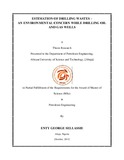| dc.description.abstract | Despite its numerous benefits the search and production of crude oil poses a lot of dangers to the environment. Among these include land, water and air pollution. Prominent among the major sources of E&P waste is drilling operations which form the second largest source of waste after production activities. The major drilling wastes are drill cuttings, drilling mud and obnoxious gas emissions. These wastes are introduced into the environment through intentional as well as accidental discharges and this expulsion into the environment has direct and indirect effects on aquatic life, personnel working on the rig, plants, flying birds, as well as the soil.
This research work purposes to identify the various forms of drilling waste, their effect on the environment and to develop strategies in managing these waste effectively. The ability to effectively identify, quantify, classify and adopt strategies to eliminate or reduce the impact of drilling waste on the environment defines an effective waste management practice. In all situations source reduction of waste is the most favorable and economically feasible drilling waste management option and should in all cases be a priority over the other methods of waste management.
However, this task of adopting an effective waste management tactics is not as simple as it looks. In its quest to developing effective strategies for managing drilling waste, it is identified that the quantity of waste generated plays an important role in drilling waste management. It dictates the type of waste management method to adopt, the design of waste boxes, waste disposal cost among others. A simple user-friendly spreadsheet is therefore
developed for waste volume estimation.
Again, a ten steps effective waste management procedure is developed to serve as guidelines for drawing waste management plans. Waste management plans should be updated regularly to capture changes in regulations, new technologies and new operations. In conclusion it is shown that the choice of the ideal drilling waste management is usually dependent on the local regulations in place, technical efficiencies, cost and the quantity of waste. The selection should always be therefore subjected to effective environmental, economic and technical analysis. As a result, a waste selection criterion has been developed which will help eliminate some of the options that are not favorable. | en_US |

